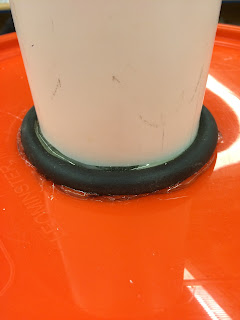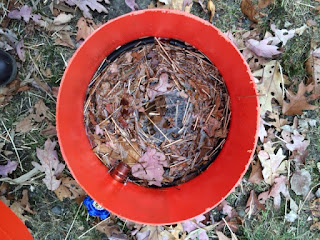For our second prototype, we major some slight, but significant adjustments.
1) We flipped the top bucket so that it rests inside the lower one, to better ensure the gas is sealed inside the biodigester and won't escape.
2) We designed the two buckets to be taken apart easily, but they fit together securely enough to not separated unintentionally. This allows the top bucket to rise when fill with methane gas, giving a visual indicator when methane is ready to be released. Also, it allows us to easily empty out and clean the bottom after most of the water has been drained.
3) We also changed the faucet we were using for gas to one which will fit with a propane connection. both faucets are reinforced with extra caulking, as the design is dependent on there being no water or gas leaks.
Tuesday, November 24, 2015
Saturday, November 21, 2015
2nd Test Run
After pouring water in (about 3/4 the way up the bottom bucket) we dropped in all the play dough and mixed it up.
We were happy to see that it was still easy to mix with our mixing stick (a normal stick that we deemed the mixing stick), and we let it all sit for a few minutes before turning the faucet to let the water come out.
Once we got out as much water as possible, we took the top bucket off and were satisfied with the manure-like mess that had accumulated at the bottom. We were able to transport the bottom bucket of stuff over to a woodsy area and dump it out (though likely anyone using this would dump it into another bucket or wheelbarrow).
We still have 2 really minor leaks, which we'll be able to fix with some additional caulking, but other than that we are pretty satisfied with our 2nd prototype and will be ready to present on Tuesday. Unfortunately we will not be able to test the gas faucet, as we do not have access to the proper materials that would allow for actual biodigestion to occur (nor is it the right climate/temperature for these processes to occur quickly), but we hope that in a better climate and with the right material enough methane will be produced to serve the hopes of Grupo Fenix.
Friday, November 20, 2015
Instructions
Bucket instructions:
- Go from bottom of first bucket and draw line 2" (~5 cm) up from the end around the entire width of the bucket
- Repeat above step, but use second bucket and draw line 3 3/4" (~9.5 cm) around width of bucket
- Using pliers (or other tool), remove handles from bucket
- Pick a point on the line of each bucket and drill a hole big enough for blade of jigsaw to enter
- Use jigsaw to cut along line of each bucket; dispose of end pieces.
- Flip first bucket upside down (keeping lid attached) and let it sit on table. With second bucket, take lid off and keep bucket upright. Place second bucket inside of first bucket; this should be a tight arrangement, but will prevent any gas or water leakages.
- On second lid, find center point and draw circle with diameter 3 3/4" (~9.5 cm)
- Use drill to make a hole on one point of circle on lid; use jigsaw to cut out circle
- Stick PVC pipe through this circle; should be wide enough to push PVC pipe through and hold it in place
- Take a 13 1/2" (~34 cm) measurement of foam tube and use glue to affix foam tube to PVC pipe at approximately 4" from the top of PVC pipe. When PVC pipe is sitting inside the circle of the top bucket lid, this foam should touch the bucket lid, leaving 4" of PVC pipe above lid and 15" of PVC pipe below lid.
- Glue the foam to the lid and make the seal airtight with caulking glue. Use a generous amount and leave overnight to dry.
Stick the threaded part of the valve into the hole, and screw on the brass fitting from the inside. Thread two 8/32" screws through the smaller holes, and secure them with two 8/32 nuts on the inside. Seal the valve in place using a generous amount of caulking, both on the inside of the bucket and on the outside around the water valve. This needs to be airtight and leakproof.
13. To attach the gas valve (red), drill a .65" diameter hole in the top bucket 5.25" down from the lid. Insert the longer end of the valve into the hole, and attach the thin fitting from the inside of the bucket. Secure with caulking, sealing any gaps on the outside and the inside.
Materials
Materials needed:
2 5-gallon (19-litre) buckets with lids
1 gas faucet (check with Amy for size/type/pieces)
1 water faucet (check with Amy for size/type/pieces)
2 brass fittings (check with Amy for size/type/pieces)
2 8-32 screws and accompanying nuts
1 PVC pipe with cap --> measurement should be 3.5" across outer diameter; 19" (~50cm)
1 Weather-Resistant EPDM Foam, Tube, 7/16" OD, 1/4" ID, (Recommended: 3' or 1 metre long)
Permanent marker
Measuring tape or ruler
Drill (ask Larry what type and what size drill bit)
Saw (Jigsaw)
Caulking glue (or glue of equivalent strength; if tube of 10.5 oz, less than 1/4 tube will be used)
McMaster-Carr numbers:
2 5-gallon (19-litre) buckets with lids
1 gas faucet (check with Amy for size/type/pieces)
1 water faucet (check with Amy for size/type/pieces)
2 brass fittings (check with Amy for size/type/pieces)
2 8-32 screws and accompanying nuts
1 PVC pipe with cap --> measurement should be 3.5" across outer diameter; 19" (~50cm)
1 Weather-Resistant EPDM Foam, Tube, 7/16" OD, 1/4" ID, (Recommended: 3' or 1 metre long)
Permanent marker
Measuring tape or ruler
Drill (ask Larry what type and what size drill bit)
Saw (Jigsaw)
Caulking glue (or glue of equivalent strength; if tube of 10.5 oz, less than 1/4 tube will be used)
McMaster-Carr numbers:
4339T1 , quantity 1 (rubber hose for sealing)
2426K24, quantity 1 (pvc pipe)
9102K223, quantity 1 (pipe cap)
Tuesday, November 10, 2015
Timeline & Pride/Pain Points
Timeline:
Pride/Pain Points (as of November 10, 2015)
- November 24th = deadline for almost final prototype!
- BY November 13th, finalize all materials that we want for our project and for the Nicaragua group to make it; also have buckets ready for use
- Be ready for test run by the end of Tuesday the 17th (so that we can do test run on the 20th and make minor modifications)
- Be totally done by end of class on the 20th
- Make time for blog (at least 15-20 minutes at the end of every class)
- Email Lyndsay by Friday (the 13th) with update on overall status of project
Pride/Pain Points (as of November 10, 2015)
- Pride: Pretty much functioned the way we expected (need to make modifications, but these were modifications we anticipated having to make for prototype #2)
- Pride: Low-cost! Low-time commitment!
- Pain: Faucet leaking - faucet was small (as in, didn't allow much water flow), we need to figure out a better way to attach it to the bucket because the little holes where the screws went caused some leaks
- Pain: Bottom of bucket is hard to take off (we think this will be a persistent issue and something we don't want to change)
Notes from test run with prototype #1
Today during class we decided to do a test run with our first prototype! Because we presented to the class the other day, we had already anticipated some of the design flaws that we ended up seeing in our test run, but we wanted to make sure that changes made for our second prototype were as informed as possible. Below are notes, observations and pictures from this test run:
- 3/4 bucket of water, 1/2 bucket of materials (ideally 1:1, but due to design flaws this is what we had to use)
- materials were: dirt, leaves, dry grass, water
- used the stick to stir (through the PVC pipe)
Observations:
- 3/4 bucket of water, 1/2 bucket of materials (ideally 1:1, but due to design flaws this is what we had to use)
- materials were: dirt, leaves, dry grass, water
- used the stick to stir (through the PVC pipe)
Observations:
- removed the top bucket to pour water in -- ideally should only be removed when cleaning and starting fresh; PVC pipe should be used for adding materials
- PVC pipe too long --> made it hard to stir and hard to put in more materials
- should firmly attach lining of the inner tray and should also be bigger (resulted in leaks when trying to empty out)
- faucet needs to be moved lower (in general, draining of water worked but faucet was too high which meant that we had to add a LOT more water - ideally faucet lower so that all water can drain w/o having to be tipped) ... took a long time for water to drain
- faucet needs to be air-tight/not leak --> big leaks out the holes of the faucet (where the screws are)
- top bucket should be moved higher to allow for more material to be added
- need for constant stirring (we suggest using a stick from the great outdoors rather than creating one from artificial materials)
- weren't able to make use of the gas faucet so can't comment on it
- semi-difficult to remove bottom bucket but is a design flaw we are willing to accept
In-Class Design Presentation
Biodigester Feedback:
Concerns-
- access to bottom
- leakage --> sealing top chamber
- having top chamber inside bottom [water seal?]
- funnel at top
- color? orange is +++! [Park Spark! idea]
- stick for turning/mixing
For next prototype-
- consider original model w/water seal (inside gas chamber)
- better faucet for gas --> research (?)
- rethink bottom --> easier to remove
- labels --> max. fill line, max. waste line --> see-thru? kinda?
- funnel @ top (could help direct in the materials)
Concerns-
- access to bottom
- leakage --> sealing top chamber
- having top chamber inside bottom [water seal?]
- funnel at top
- color? orange is +++! [Park Spark! idea]
- stick for turning/mixing
For next prototype-
- consider original model w/water seal (inside gas chamber)
- better faucet for gas --> research (?)
- rethink bottom --> easier to remove
- labels --> max. fill line, max. waste line --> see-thru? kinda?
- funnel @ top (could help direct in the materials)
Subscribe to:
Comments (Atom)



















